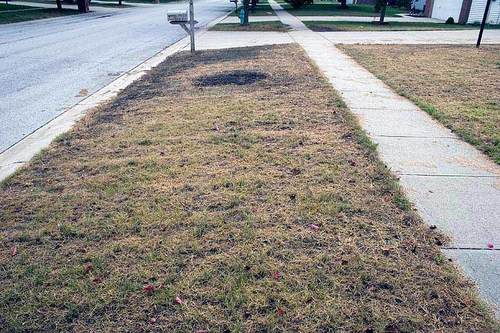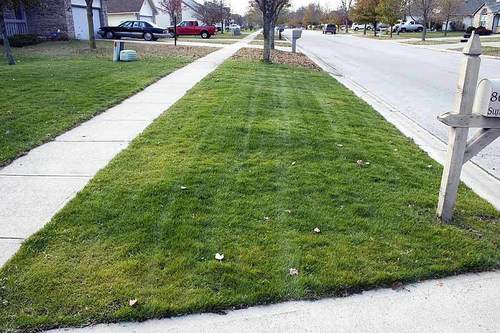Email: info@maplewoodlawn.com | Address: 2098 Jackrabbit Rd Hiawatha, KS 66434
Grass Seeding/Overseeding
According to Money Magazine, a professional-looking lawn can return up to 200% of the original investment when you sell your property.
Let
Maple Wood Lawn Care professionally install that lush, green lawn you've always wanted. If your lawn is in bad shape, new turf will have your yard looking great. We will provide a new lawn to your specifications and professionally install it with minimal inconvenience to you. For more information or to get started today call us at
785-742-2882.


Lawn Seeding
Starting a lawn from seed is the least expensive way to transform your yard with a new lawn. Also, it is an easy way to reinvigorate areas of your lawn where the turf may be a little sparse. The best time to start lawns from seed usually is just before the grass season of most vigorous growth. Let us help you determine the best type of grass with which to seed your lawn and when to do it. Let's turn that grass seed into a lush, beautiful lawn.
Care Instruction For Newly Seeded/Overseeded Lawn And Sod Lawn.
-
Watering
Newly seeded or sodded lawns require special irrigation. A newly seeded lawn requires daily watering and may need as many as four light waterings in a single day if conditions are dry and windy. Keep the seedbed moist but not saturated to a depth of 1 to 2 inches until germination occurs (green cast to lawn and seedlings 1/4 to 1/2 inch tall). At this stage, it is crucial that seedlings not be stressed to the point of wilt.
Continue to water one to four times a day with light applications, about 1/8 to 1/4 inch of water per day. Straw applied at the time of seeding helps to shade the soil and to prevent rapid drying of the soil surface. It will also reduce soil erosion and seedling damage from the force of large sprinkler drops.
Watering with a light mist is best for establishing new lawns. As seedlings reach 2 inches, gradually reduce the frequency of watering and water more deeply. Begin mowing once a week when the seedlings reach a height of 3 inches. After the new lawn has been mowed two or three times, water deeply and infrequently.
Newly sodded lawns may require watering one or two times a day. Begin irrigation immediately after laying sod. Plan your sodding operation so that a section of laid sod can be watered immediately while other areas are being sodded. Water sod enough to wet the sod strip and the top inch of soil below the sod.
The first irrigation requires about 1 inch of water to achieve complete wetting of the sod. After watering, lift up pieces of sod at several locations to determine if it has been adequately irrigated. Continue watering one to two times a day or as needed with light irrigations to prevent wilting and to ensure moist soil just below the sod layer. As sod becomes established and roots penetrate and grow in the soil, gradually reduce the frequency of watering but wet the soil deeper. After the sod has been mowed two or three times, water deeply and infrequently.
During hot, windy conditions, establishing sod may require several light mistings per day to prevent wilt and potentially lethally high temperatures. In this case, mist the sod lightly just to wet the leaf surface and not to supply water to the soil. Misting cools the grass plant as water is evaporated from the leaves.
Do not over irrigate the soil because that will inhibit sod roots from growing into the soil. In situations where daily watering is not possible, thoroughly water the sod and soil to a depth of 6 inches. This will delay the rooting time of sod but will reduce the chance of rapid drying and severe loss of grass.
-
Mowing
A common mistake is to wait too long before mowing new grass. As soon as cool-season grasses reach a height of 3 inches, mow with a sharp mower blade set at the height of 2 inches. New grass is succulent, so it is best to mow on a warm afternoon when the grass and soil are drier. Continue mowing at the height of 2 inches through the last mowing of the season. Warm-season grasses should be mowed one to 2 inches tall during establishment. Regular mowing stimulates the grass to spread rather than grow upright. Cool-season grasses are winter hardy and do not need to be left long for winter protection. Warm-season grasses should be mowed 1⁄2 to 1 inch taller at the end of the season. Taller mowing will help protect sensitive growing points during the winter months.
Spring and Fall Clean Ups
Hate raking leaves or hauling debris? Leave it to us. No matter what season, we can clean up that yard and leave it looking great. We turn what is normally a dreaded job into a simple task. Just call us, and we will take care of it for you!
We offer Spring and Fall Clean-Up to help spruce up your yard throughout the Fall and Winter and in preparation for new growth in the Spring. Removing leaves, limbs, debris, and dethatching will give you a healthy, safe, and beautiful lawn year-round. Reasonable rates!
Maple Wood Lawn Care strives to be your Lawn Specialist! We solely focus on turf maintenance so you can focus on your business. Property owners love us because we make their job easy. For further information, call
785-742-2882.
Phone: 785-742-2882 | Address: 2098 Jackrabbit Rd Hiawatha, KS 66434 | Email: info@maplewoodlawn.com
Business Hours: M-F 8-5
Licensed | Bonded | Insured





